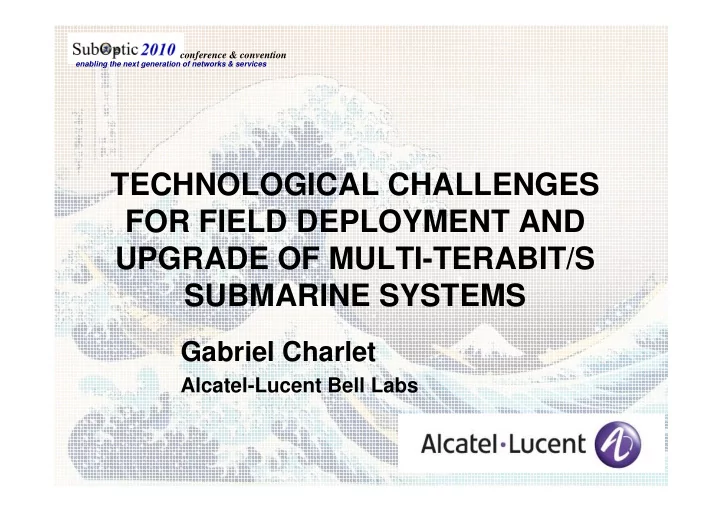

conference & convention enabling the next generation of networks & services TECHNOLOGICAL CHALLENGES FOR FIELD DEPLOYMENT AND UPGRADE OF MULTI-TERABIT/S UPGRADE OF MULTI-TERABIT/S SUBMARINE SYSTEMS Gabriel Charlet Alcatel-Lucent Bell Labs
conference & convention enabling the next generation of networks & services Presenter Profile Gabriel CHARLET was born in Rueil Malmaison (France) in 1976. He joined Place Alcatel Research and Innovation in picture 2000. Since then he has been working here on WDM transmission systems and on WDM transmission systems and realized several multi-terabit/s transmission records presented in conferences. Gabriel Charlet Email: gabriel.charlet@alcatel- lucent.com Tel: (+33) 1 7033 2708
conference & convention enabling the next generation of networks & services From 10Gb/s channel rate to 40Gb/s (and then 100Gb/s) � State of the art 10Gb/s systems can transport ~1.6Tb/s per fiber (10Gb/s DPSK, 25GHz channel spacing) � Submarine requirements for 40Gb/s and 100Gb/s : � Long distance (>6000km) with sufficient system Q margins � Excellent OSNR sensitivity � Large tolerance to linear distorsions (dispersion, PMD…) � Superior non linear tolerance � Compact optical spectrum for high capacity system �
conference & convention enabling the next generation of networks & services Evolution of information spectral density over the last 15 years ���� ������� � Commercial system �������������� ������ � operates at 10Gb/s for 10 years ! ������ ��� ��������� ���� ���� ������������������ � Shift to 40Gb/s to � Shift to 40Gb/s to "��������� increase capacity has not ����� ������� ��� yet appeared commercially due to suboptimum 40Gb/s ���� proposals until very recently ���� ��� ��� ��� !����
conference & convention enabling the next generation of networks & services Alcatel-Lucent 40Gb/s solution � Association of : � Binary PSK to keep superior non linear tolerance � Polarization division multiplexing (PDM) to double system capacity � coherent detection to improve noise sensitivity � digital signal processing to compensate for linear impairment and for efficient polarization demultiplexing
conference & convention enabling the next generation of networks & services 40Gb/s Transponder description ' ������� #$%& � Transmitter (���� #$%& #$%& ��� ������ ��# )*" ���������� � � Coherent �������� ° ��� ����� receiver )*" �� ° ��� *��� *%$ )*" �������� � ��� ����� �� )*" ° $#%
conference & convention enabling the next generation of networks & services Upgrade of 10Gb/s systems to 40Gb/s • Large number of deployed systems are based on NZDSF and have been deployed with 10G OOK channels • 40Gb/s should be compatible with such • 40Gb/s should be compatible with such systems, with 10G channels running and provide similar performance
conference & convention enabling the next generation of networks & services Upgrade of 10Gb/s systems to 40Gb/s 7254km long NZDSF • Similar performance obtained with 10Gb/s and 40Gb/s. • Excellent cohabitation of 10G and 40G channels
conference & convention enabling the next generation of networks & services 40Gb/s over +D/-D systems • Modern, high capacity and long distance systems are mainly based on the association of +D/-D fiber. 9225km +D/-D line 9225km +D/-D line • 40Gb/s Transpacific systems are feasible !
conference & convention enabling the next generation of networks & services 40Gb/s over +D only cable • Using +D only cable is a good way to reduce span loss (or increase span length at constant span loss) • Coherent detection offers the capability to compensate chromatic dispersion. compensate chromatic dispersion. • But a 10,000km cable based on fiber with 20ps/nm/km dispersion has a huge total cumulated dispersion of 200,000ps/nm • Such value is really challenging to compensate by “true” real time transponder today but could be feasible soon.
conference & convention enabling the next generation of networks & services System performance over +D only cable • Transpacific distances can be reached by using 80km long span.
conference & convention enabling the next generation of networks & services 100Gb/s transmission 15.5Tb/s over 7200km • Highest capacity obtained at 100Gb/s even if propagation over submarine distance with submarine distance with large Q margin (>3dB) is still challenging. • Up to 15.5Tb/s over 7200km has been demonstrated.
conference & convention enabling the next generation of networks & services Conclusion • 40Gb/s is now mature for submarine implementation to offer a fiber increased capacity. capacity. • For new systems as well as for upgrade. • 100Gb/s will be ready soon to offer even more capacity, first on regional systems, then on transoceanic links.
2010 conference & convention enabling the next generation of networks & services The 7th International Conference & Convention on Undersea Telecommunications Pacifico Convention Plaza Yokohama & InterContinental The Grand Yokohama 11 ~ 14 May 2010 www.suboptic.org
conference & convention enabling the next generation of networks & services Single channel vs dual channel 3.5dB • Single channel PDM BPSK is superior to dual channel, especially in center region of NZDSF links.
Recommend
More recommend